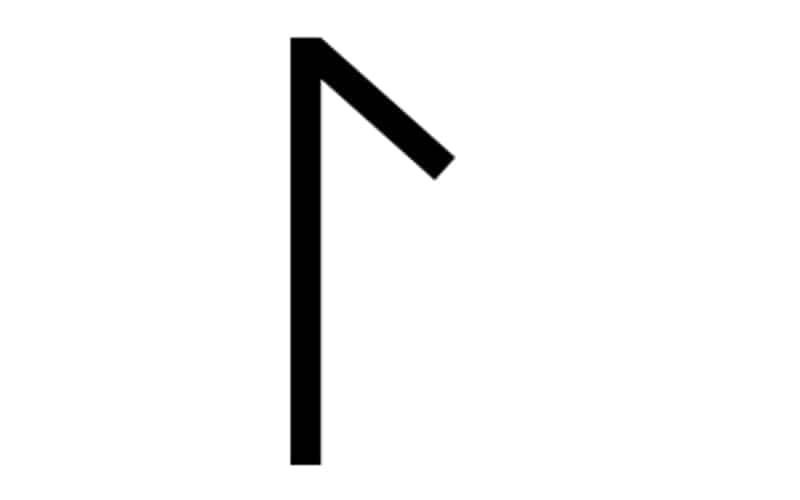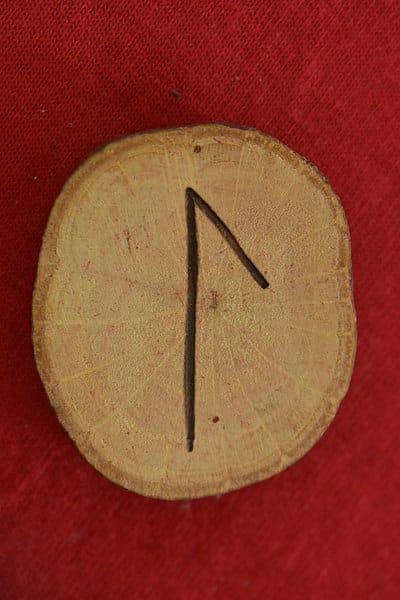As the last rays of the sun kiss the horizon goodbye, we gather around the warmth of the fire, ready to embark on a journey into the past. Our destination? The Elder Futhark, the oldest form of the runic alphabets used by the Germanic tribes. In this post I am looking at the 21st rune, Laguz, a symbol as deep and enigmatic as the waters it represents.
Laguz: Background and Description
In the hushed whispers of the ancients, the Elder Futhark was born. This runic system, used from around the 2nd to 8th centuries, was the alphabet of the Proto-Germanic language, the mother tongue of many modern European languages. When providing an age range for when it was in use I feel it’s important to point out that the transition into the Younger futhark moved slowly, and at different rates across Northern Europe.
Our focus is the 21st rune of this system, Laguz. It finds its place between Mannaz, the rune of humanity, and Ingwaz, the rune of fertility and internal growth. A symbol of water, Laguz is a testament to the importance of this life-giving element in the lives of the ancient Germanic tribes.
The name Laguz, derived from the Proto-Germanic language, carries the meaning of “water” or “lake”. In Old English, it was known as Lagu, symbolizing the “ocean” or “sea”. The Old Norse interpretation of Laguz, called Lögr, translates to “water” or “waterfall”. This rune, like a river, has flowed through time, its essence remaining unchanged, its symbolism as vital as the life-giving waters it represents.
Graphical Representation

Visualize Laguz as a upwards pointing arrow, its tip missing the diagonal line on the left side. This simple yet profound design is a mirror to its meaning – a symbol of water, life’s flow, and the connection between the heavens and the earth.
Over the centuries, the design of Laguz has remained consistent, a testament to its enduring significance in the Elder Futhark. Its form, like the water it represents, is fluid yet constant, changing yet unchanging.
Phonetic Value
In the language of the runes, each symbol carries a phonetic value. For Laguz, this value is the sound of the letter “L”, as in “lake”. This phonetic value has remained consistent across different Germanic languages, a linguistic thread weaving through the tapestry of time.
Symbolic Meaning of the Laguz Rune
The Laguz rune, with its ties to water, is a symbol of life, flow, and change. In Proto-Germanic, the translation of Laguz is “water”, a vital element in Norse mythology. Water is the realm of the sea god Njord and his children, the beautiful Freyja and the bountiful Freyr. These deities, associated with wealth, fertility, and prosperity, reflect the life-giving qualities of water.
Water, in the ancient Germanic worldview, was not just a physical element. It was a symbol of the ebb and flow of life, the cycles of birth, death, and rebirth. The Laguz rune, with its connection to water, embodies this understanding of life as a constant flow of change.
The Aett and its Symbolism
Laguz belongs to the third aett of the Elder Futhark. This aett is called Tyr’s aett because this group of eight runes is associated with the god Tyr. Tyr, the god of law and heroic glory, (remember he lost his hand to Fenrir) lends his qualities of order, justice, and righteous action to this aett.
The third aett, with its themes of order and justice, is a reflection of the cosmic law that governs the universe. Each rune within this aett, including Laguz, contributes to this overarching theme. Laguz, with its associations of flow and change, adds a dynamic element to this aett, reminding us that life, like water, is a constant flow of change within the framework of cosmic law.
Tyr, the god associated with this aett, is a figure of courage and justice. His influence on the third aett, and on the Laguz rune, is a reminder of the need for righteous action and moral courage in the face of life’s challenges.
Elder Futhark Quiz
Do you want to test your knowledge of Elder Futhark runes? Then this quiz is perfect for you!
Don’t forget to play our other games as well!
Laguz Used in Divination and Magic

While I don’t personally subscribe to the practice of divination or magic, I find the historical and cultural aspects fascinating. In runic divination, Laguz often signifies a need to go with the flow, to accept the changes life brings, and to find wisdom in adaptability.
In magical practices, Laguz could be used in spells or rituals related to emotional healing, intuition, or dreams. The water symbolism of Laguz lends itself to such uses, as water is often associated with emotions, intuition, and the subconscious.
Historically, the runes were used not just for writing, but also for divination and magic. While we may not fully understand the ways in which the ancient Germanic tribes used the Laguz rune in their magical practices, we can appreciate the rich cultural and spiritual heritage that it represents.
Frequently Asked Questions
The Laguz rune symbolizes water, life’s flow, and change.
The Laguz rune associates with the sea god Njord and his children, Freyja and Freyr.
The phonetic value of the Laguz rune is the sound of the letter “L”.
The Laguz rune belongs to the third aett, which is under the governance of the god Tyr.
Featured Image Credit: BK, Public domain, via Wikimedia Commons
